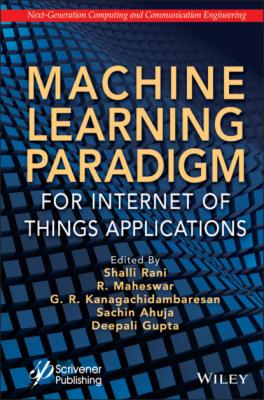Machine Learning Paradigm for Internet of Things Applications. Группа авторов
Читать онлайн.| Название | Machine Learning Paradigm for Internet of Things Applications |
|---|---|
| Автор произведения | Группа авторов |
| Жанр | Программы |
| Серия | |
| Издательство | Программы |
| Год выпуска | 0 |
| isbn | 9781119763475 |
13 9 Route Optimization for Perishable Goods Transportation System 9.1 Introduction 9.2 Related Works 9.3 Proposed Methodology 9.4 Proposed Work Implementation 9.5 Conclusion References
14 10 Fake News Detection Using Machine Learning Algorithms 10.1 Introduction 10.2 Literature Survey 10.3 Methodology 10.4 Experimental Results 10.5 Conclusion References
15 11 Opportunities and Challenges in Machine Learning With IoT 11.1 Introduction 11.2 Literature Review 11.3 Why Should We Care About Learning Representations? 11.4 Big Data 11.5 Data Processing Opportunities and Challenges 11.6 Learning Opportunities and Challenges 11.7 Enabling Machine Learning With IoT 11.8 Conclusion References
16 12 Machine Learning Effects on Underwater Applications and IoUT 12.1 Introduction 12.2 Characteristics of IoUT 12.3 Architecture of IoUT 12.4 Challenges in IoUT 12.5 Applications of IoUT 12.6 Machine Learning 12.7 Simulation and Analysis 12.8 Conclusion References
17 13 Internet of Underwater Things: Challenges, Routing Protocols, and ML Algorithms 13.1 Introduction 13.2 Internet of Underwater Things 13.3 Routing Protocols of IoUT 13.4 Machine Learning in IoUT 13.5 Performance Evaluation 13.6 Conclusion References
18 14 Chest X-Ray for Pneumonia Detection 14.1 Introduction 14.2 Background 14.3 Research Methodology 14.4 Results and Discussion 14.5 Conclusion Acknowledgment References
19 Index
List of Illustrations
1 Chapter 1Figure 1.1 Bhubaneswar smart city structure.Figure 1.2 Pune smart city overview.Figure 1.3 Funds raised by government of India.Figure 1.4 Physical infrastructure workflow.Figure 1.5 Water supply chain in city structure.Figure 1.6 Smart city control flow for command and control centers.
2 Chapter 2Figure 2.1 System diagram of “isRice”.Figure 2.2 Structure of RNN.Figure 2.3 Output feedback for RNN.Figure 2.4 Structure of a standard RNN cell.Figure 2.5 Structure of a standard LSTM cell.Figure 2.6 Chromosome structure.Figure 2.7 One-point crossover.Figure 2.8 Mutation: swap operator.Figure 2.9 Business model of “isRice”.Figure 2.10 “isRice” main interface.Figure 2.11 Harvest prediction interface.Figure 2.12 Demand prediction interface.Figure 2.13 MAE for train set and test set: Paddy harvest prediction.Figure 2.14 MAE for train set and test set: Rice demand prediction.Figure 2.15 Number of generations vs. fitness value.Figure 2.16 Time vs. number of consumer districts.
3 Chapter 3Figure 3.1 Data collection and publishing model.Figure 3.2 Classification accuracy.Figure
